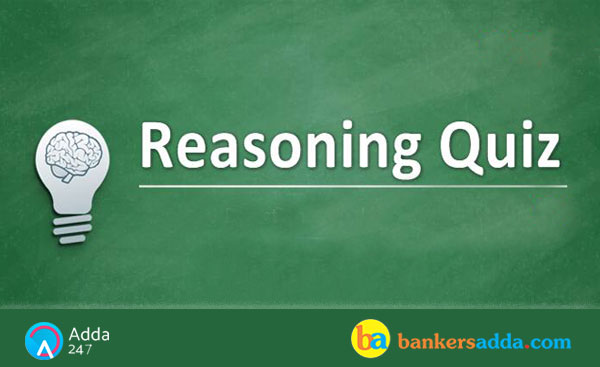
Directions (1-5): Study the following information carefully to answer the given questions.
Eight persons from different ministry viz. Defense Ministry, Home Ministry, Labour Ministry, Minority Ministry, Heavy industry Ministry, Finance Ministry, Agriculture Ministry and External affairs Ministry are sitting in two parallel rows containing four people each, in such a way that there is an equal distance between adjacent persons. In row-1 A, B, C and D are seated and all of them are facing south. In row-2 P, Q, R and S are seated and all of them are facing north. Therefore, in the given seating arrangement each member seated in a row faces another member of the other row.
C sits second to right of the person from External affairs Ministry. R is an immediate neighbour of the person who faces the person from External affairs Ministry. Only one person sits between R and the person for Minority Ministry. Immediate neighbour of the person from Minority Ministry faces the person from Labour Ministry. The person from Defense Ministry faces the person from Finance Ministry. R is not from Finance Ministry. P is not from Minority Ministry. P does not face the person from External affairs Ministry. Q faces the person from Heavy Industry Ministry. The one who faces S sits to the immediate left of A. B does not sit at any of the extreme ends of the line. The person from External affairs Ministry does not face the person from Home Ministry.
Q1. Which of the following is true regarding A?
Q2. Who is seated between R and the person from Minority Ministry?
Q3. Who amongst the following sit at extreme ends of the rows?
Q4. Who amongst the following faces the person from External affairs Ministry?
Q5. P is related to Heavy Industry Ministry in the same way as B is related to Minority Ministry based on the given arrangement. To whom amongst the following is D related to, following the same pattern?
Directions (6-10): In these questions symbols ©, #, ¬, $ and @ are used with different meanings as follows:
‘M © N’ means ‘M is smaller than N’
‘M# N’ means ‘M is either smaller than or equal to N’
‘M ¬ N’ means ‘M is greater than N’
‘M $ N’ means ‘M is either greater than or equal to N’
‘M @ N’ means ‘M is neither smaller than nor greater than N’
In each of the following questions assuming the given statements to be true, find out which of the two conclusions I and II given below them is/are definitely true. Give answer
Q6. Statements : V # S, S © L, L© J
Conclusions: I. V© L II. S © J
Q7. Statements : M # R, R © J, J # H
Conclusions: I. M # H II. R © H
Q8. Statements : H $ F, F @ G, G ¬ M
Conclusions: I. H ¬ M II. H ¬ G
Q9. Statements : R © J, J ¬ T, T # L
Conclusions: I. R @ T II. J @ L
Q10. Statements : W @ T, T $ K, K ¬ F
Conclusions: I. W $ K II. W @ K
Directions (11–15): In each question below are given some statements followed by some conclusions. You have to take the given statements to be true even if they seem to be at variance with commonly known facts. Read all the conclusions and then decide which of the given conclusions logically follows from the given statements, disregarding commonly known facts. Give answer
Q11. Statements: All bags are purses.
No purse is black.
All blacks are covers.
Conclusions: I. All bags are covers
II. Some covers are purses.
Q12. Statements: Some cats are rats.
Some rats are fishes.
All fishes are birds.
Conclusions: I. Some fishes are rats.
II. All cats being birds is a possibility
Q13. Statements: Some flowers are roses.
No rose is red.
All red are leaves.
Conclusions: I. Some flowers are definitely not red.
II. Some leaves are definitely not roses.
Q14. Statements: All cards are sheets.
All files are cards.
Some sheets are papers.
Conclusions: I. All files being papers is a possibility.
II. All files are not sheets.
Q15. Statements: All fans are pins.
No pin is a clip.
No clip is a cap.
Conclusions: I. Some fans are not clips
II. No pin is a cap.
You may also like to read:





 GA Capsule for SBI Clerk Mains 2025, Dow...
GA Capsule for SBI Clerk Mains 2025, Dow...
 The Hindu Review October 2022: Download ...
The Hindu Review October 2022: Download ...
 ECGC PO Scorecard 2025 Out, Check Marks
ECGC PO Scorecard 2025 Out, Check Marks




